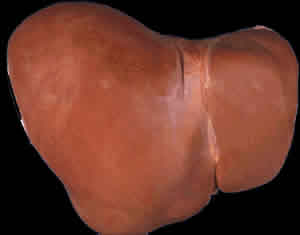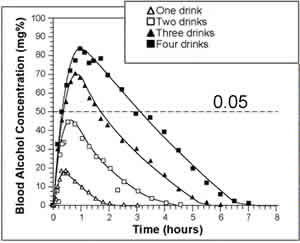The liver is a large organ that rests on top and to the right of the stomach. It is responsiblre for the chemical breakdown of many substances that are absorbed into the blood stream including alcohol. Chemicals found in the liver, known as enzymes, break down alcohol at a constant rate no matter how much alcohol is consumed.
A small amount of the consumed alcohol escapes the body unchanged via the urine and lungs and forms the bases of modern day detection methods.


The graph on the right shows the blood alcohol concentration after the rapid consumption of different amounts of alcohol by eight adult males on an empty stomach. (Adapted from Wilkinson et al., Journal of Pharmacokinetics and Biopharmaceutics5(3):207-224, 1977.)

Food can influence the rate at which alcohol is absorbed into the blood stream.which depends on how quickly the stomach empties its contents into the small intestine. Food containing fat tends to take longer to empty out of the stomach. One particular study found that people who drank alcohol after a meal that included fat, protein and carbohydrates absorbed the alcohol into their blood about three times slower than those who drank the same amount of alcohol on an empty stomach.
Differences between gender also exist. The average body mass of males is generally higher than females. Generally,the bodies of males have more water and less body fat and so the alcohol is less concentrated in their body and so it affects them less quickly. Taking this into account it is advised that, to stay below the 0.05 limit, females consume no more than one standard drink per hour while males consume no more than 2 standard drinks in the first hour and no more than one standard drink every hour after.
A person who has quickly consumed two standard drinks will